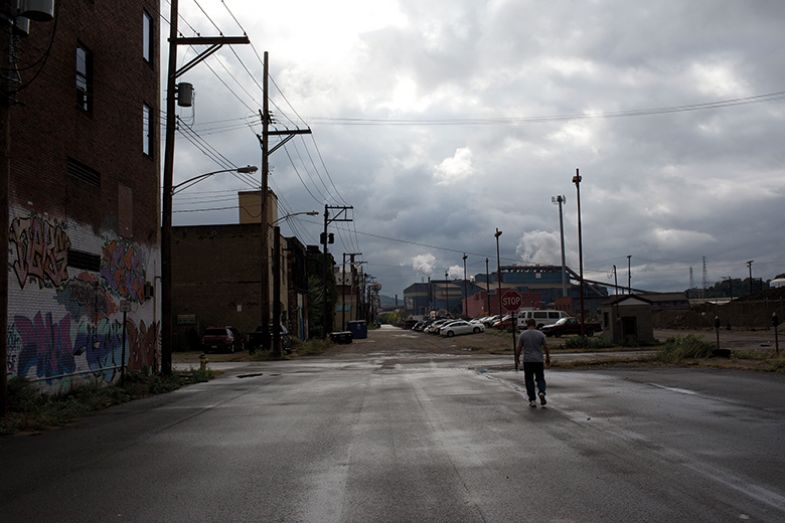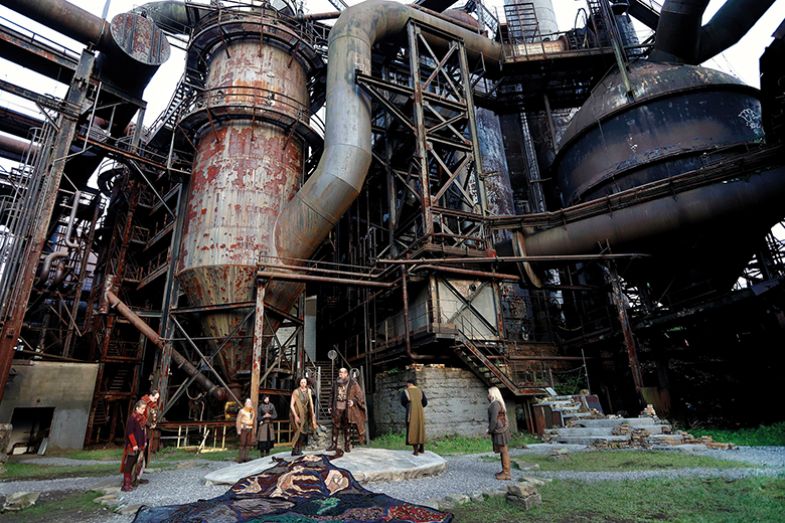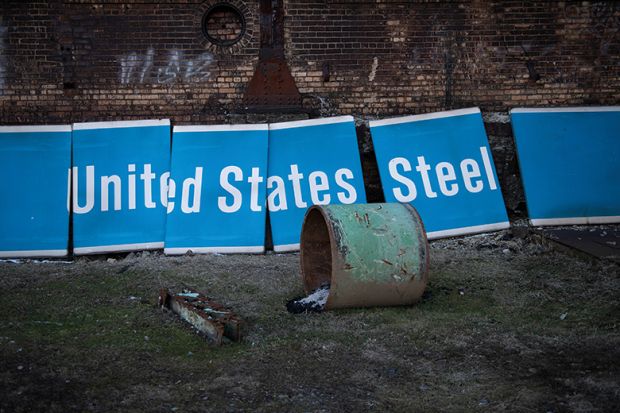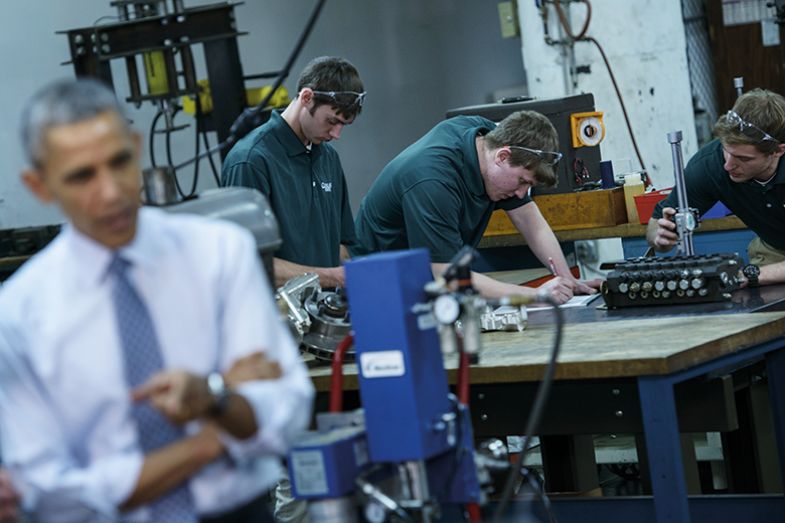The streets of Oakland, Pittsburgh are bustling. Hordes of backpack-wearing students flow past the stacked glass boxes of Carnegie Mellon University’s renowned computer sciences department. Others throng around the University of Pittsburgh’s 42-storey Gothic revival “Cathedral of Learning”, which looks like a piece of Emerald City skyline from The Wizard of Oz, and around the huge University of Pittsburgh Medical Center hospital, part of a life sciences hub with designs on becoming a regional powerhouse.
It all speaks to the ever-growing importance of Pittsburgh’s university district as a key engine of economic revival in the Rust Belt city. It is no coincidence that a couple of miles north, across affluent neighbourhoods still living up to the calculatedly leafy names of Shadyside and Squirrel Hill, are the headquarters of Duolingo, the language edtech start-up founded by a CMU professor, as well as Google’s Pittsburgh office, home to its shopping operations team. Further downtown are the offices of Apple and of Facebook owner Meta. There, too, are the headquarters of Pittsburgh start-up Aurora, part of the city’s autonomous vehicle sector.
This mix has led the former steel city in western Pennsylvania to be dubbed the guiding light of “a Rust Belt rebound”, in the words of one 2018 Bloomberg article. But the city is by no means sitting back and basking in its supposed success. Rather, it is pushing ahead with plans to scale up a university-led innovation economy that could offer lessons for post-industrial regions not only across the US but throughout the developed world. That is why it is the centrepiece of a study tour of the Midwest region focused on “renewal of heartland industrial regions” convened by John Austin, a non-resident senior fellow at US thinktank the Brookings Institution, and Andy Westwood, professor of government practice at the University of Manchester, and attended by regional development experts from the European Commission, the Organisation for Economic Cooperation and Development and Germany’s Ruhr region – as well as Times Higher Education.
First stop is Mill 19, a lonely former steel mill building standing where once a forest of chimneys belched smoke into the skies, on the banks of the Monongahela River. Here, next to an Uber self-driving automobile test track secreted behind high fences, CMU aims to apply the university’s robotics, artificial intelligence and materials science expertise to advanced manufacturing – and train a new workforce for the high-tech jobs that it hopes will be the result.
Further along the Monongahela is the castle-sized Carrie Furnace, a remnant of the former Homestead Steel Works, which were abandoned to weeds and graffiti for decades but are now a tourist draw and a cultural space for “Rust Belt chic” aficionados. The furnace’s gigantic steel drums will be the centrepiece for a planned manufacturing district, for all those new industries that CMU and Mill 19 hope to create.
The wider significance of all this is reflected in the fact that Joe Biden – who has made great electoral play of his Pennsylvania heritage – has visited Mill 19 three times, last year giving a speech there on “bringing manufacturing back, jobs back” to the US. The $1 billion (£811 million) federal government programme recently launched by the US president to “create thousands of good-paying jobs in industries of the future” in 21 winning heartland regions is one example of how universities are increasingly being seen as the best bet to lead on economic development in struggling places, in the US and beyond. The UK government, for instance, has imported US thinking to shift its investment zones plan away from tax cuts to centre on universities boosting growth industries in “left-behind areas”.
As this policy shift takes shape, there’s no more important place than Pittsburgh to look for answers to the big question: whether universities’ research power can be harnessed for inclusive innovation and large-scale job creation, rather than establishing islands of knowledge and prosperity from which many local people remain excluded.

Unlike the University of Pittsburgh, Carnegie Mellon is a private university. Nevertheless, it is “very intentional in its strategy” to work with public and private partners in Pittsburgh and across the US “to promote shared prosperity and economic empowerment”, says Farnam Jahanian, CMU’s president.
How much those efforts have contributed to Pittsburgh’s already considerable economic success, however, is disputed. In 2021, for instance, the Economic Development Quarterly published a special issue on the question of “policy versus luck in Pittsburgh and Cleveland’s Economies”. The edition compared the Pennsylvania city with its Ohio peer on the shores of Lake Erie 100 miles to the north-west. Cleveland has some of the same assets as Pittsburgh, including universities, but is often perceived not to have had the same post-industrial upswing (cruel detractors have long styled the city as “the mistake on the lake”).
Ben Armstrong, executive director of the Massachusetts Institute of Technology’s Industrial Performance Center, wrote in the edition that among the primary differences between industrial policy in the two cities was “who led the implementation: universities in Pittsburgh, the business community in Cleveland”. The latter, he believes, are too focused on downtown redevelopment and “legacy industries”.
One key figure as Pittsburgh forged a new economy was Tom Murphy, mayor between 1994 and 2006 and, previously, a state legislator during the steel industry’s 1980s collapse. One of the main roots of the revival was “an entrepreneurial culture” within CMU, focused on making it easy for professors to set up companies, says Murphy, a Democrat, who is now a senior resident fellow at the Urban Land Institute, a global network of land-use experts.
As a former steel city spread across hills and woods, Pittsburgh feels a little like the UK’s Sheffield, which is pursuing a similarly innovation-led post-industrial revival. But the greater powers and financial clout of US city and state governments mean that Pittsburgh’s development has been very different. The city, says Murphy, faced a “no guts, no glory, take-no-prisoners moment – we needed a shift to reimagine Pittsburgh. To do that, we needed land control, money, sophisticated deal-making capacity and a vision.”
In 1985, the mayor, county commissioners and the presidents of CMU and Pitt agreed Strategy 21, a joint plan to “transform the economy” of the city region, prioritising not just infrastructure projects, such as expanding the city’s airport, but also “university advanced technology research” and competitive advantages, such as CMU’s expertise in computing.
That came after Richard Cyert, then CMU president, underwent something of a conversion when Carnegie Mellon won $100 million in federal funding to create a Software Engineering Institute, telling the state governor that the university was “now poised to be a powerful factor in stimulating the transition of Pittsburgh from relying on heavy industry to being a national center for advanced technology”.
Cyert’s stance had huge impact, says Murphy. He would “rattle off [the names of] people that developed stuff at Carnegie Mellon [then] left because they couldn’t get the support here…So we became very focused on building that infrastructure.”
After learning some lessons from the university-led Research Triangle Park in North Carolina, Murphy helped to draft legislation that, in 1983, led to the creation of the Ben Franklin Partnership, a statewide organisation still running today that “provides critical funding, business and technical expertise” to help both “early-stage and established companies” to expand – partly by promoting “greater collaboration among companies, academia, private investors and government”. A lack of access to finance – a situation often lamented in the US heartland – was partly addressed by legislation allowing for the investment of some of the state’s pension assets in venture capital funds provided that those funds opened an office in Pennsylvania.
MIT’s Armstrong, a former Google staffer who wrote a chapter of his thesis on the role of universities in Pittsburgh’s transition, says that in the mid-1980s, with encouragement from the state governor, CMU transitioned from “a typical academic institution that is mostly unconcerned with local economic development into a local economic development leader”.
This new role put CMU in pole position to win more federal funding directed to Pennsylvania for economic recovery, while also increasing the chances of the state winning more of that funding from central government. And it still does. In 2017, for example, CMU won $80 million from the Department of Defense to help create the Advanced Robotics for Manufacturing (ARM) Institute, housed at Mill 19. The “ability to relate research outcomes to transformative economic development is a fundamental driver shaping support for research universities”, says Jahanian.
In turn, CMU’s local economic role helps to make the region “a destination of choice for innovators”, leading to “more outstanding talent, richer pathways to opportunity and more jobs for the local economy”, Jahanian adds.
That is seen in the example of Duolingo. Its founder, Luis Von Ahn, remains a consulting professor in CMU’s computer science department, and the university continues to be important for Duolingo, according to Bob Meese, the company’s chief business officer. Pittsburgh is “not Silicon Valley”, he notes. “I think a really important piece for us is attracting a critical mass of talent and the right talent. I think that Carnegie Mellon is really the foundation for that on the tech side.”

But even assuming that Pittsburgh’s success has come about more by design than by happy accident, can the model translate to other places? One issue is that the alignment of factors in Pittsburgh’s favour may be fairly unique. The universities work closely with key city forces, such as business alliance the Allegheny Conference on Community Development, as well as with wealthy foundations endowed by the tycoons of the region’s industrial heyday. The $2 billion Heinz Endowments, for instance, gives out grants worth in excess of $70 million every year, mostly to schemes in south-western Pennsylvania.
Two of those tycoons, of course, founded the institutions that eventually merged in 1967 to form CMU. One of the co-founders, Andrew Carnegie, was the world’s richest man when he sold his Pittsburgh steel empire to J. P. Morgan in 1901. And there is plenty of remaining corporate wealth evident in the view across to central Pittsburgh from Mount Washington, a steep hill complete with funicular railway that rises from the banks of the Monongahela and its confluence with the Allegheny to form the Ohio River. The downtown region projects into the Ohio like the prow of some huge riverboat, gleaming skyscrapers as funnels.
There are other takes on the success of Pittsburgh’s economic strategy, too. Perhaps the city just lucked out by having a university with a computing specialisation during the meteoric rise of the IT industry. In the Economic Development Quarterly, critics argue that Cleveland just does not have universities of the same income and power as Pittsburgh’s, and that Pittsburgh’s jobs growth actually has not been that remarkable.
Across the road from Mill 19 is the neighbourhood of Hazelwood, which used to attract eastern European and African American migrants from the South to work at its coking plant. Since the plant shut down in 1998, the neighbourhood has lost jobs and residents, and its streets are now funereally quiet. Mill 19 aims to rectify that, but for now the area might be thought to symbolise a wider deficiency.
“Pennsylvania excels at university-based R&D but lags in high-value, high-pay job creation,” according to a report on the state’s innovation economy published in September by the Brookings Institution.
Brookings’ focus on Pennsylvania was partly driven by the state’s status as “ground zero of this divergence tendency” seen across the US and beyond: the “pull away of a few highly educated superstar places and the sideways drift of much of the country, leading to populist backlash”, says Mark Muro, senior fellow and policy director on Brookings’ Metropolitan Policy Program, an author on the report.
Advanced industries, such as precision manufacturing, vehicle automation, software development, pharmaceuticals and energy, “pack a massive economic punch that ranges from good-paying jobs and inordinate output to long supply chains and substantial ‘multiplier effects’”, making it important to spread these industries across the nation, according to Brookings. But between 2010 and 2019, “Pennsylvania saw its advanced industry jobs grow by an aggregate 10.9 per cent”, lagging behind the US as a whole by 8 percentage points and the peer state of Michigan by 23 percentage points, says the report, which criticises Pennsylvania’s lack of state-level commitment and strategy on innovation and calls on the governor to fund innovation hubs, including beyond the major cities.
“One shouldn’t discount the progress that has been made [in Pittsburgh]; it simply hasn’t become a major large-scale driver of specific employment gains,” says Muro.
The Brookings report highlights Erie, a smaller Pennsylvania city 130 miles due north of Pittsburgh, as one of the two counties in the state to have experienced the sharpest loss in their share of advanced industry jobs. Donald Trump won Erie County on his way to winning Pennsylvania in the 2016 presidential election.
Erie does not have major research universities. But it does have the Jefferson Educational Society, filling one role of a big university by bringing in external experts and convening summits, and it has designs on winning a share of the innovation economy for the city. With funding from the unusual source of the Erie County Gaming Revenue Authority, the North West Pennsylvania Innovation Beehive Network taps the expertise of Erie’s four small universities – Penn State Behrend, PennWest Edinboro, Gannon University and Mercyhurst University – to offer business development advice to local firms. Each institution specialises in a particular field, from market intelligence to environmental sustainability.
At Penn State Behrend – whose campus has views across woods down to the vast Lake Erie – the Innovation Commons ideas lab sees students providing rapid prototyping for new products, making use of resources such as 3D printers and helping job creation in a region with strength in plastics manufacturing. The university’s hope is that CMU will invest some of its own funds to boost this endeavour, spreading its efforts to support R&D across Pennsylvania more widely.

In Pittsburgh, too, there is a sense of the need to shape a different kind of innovation economy.
“We built a new economy that really doesn’t touch everybody,” former Pitt chancellor Mark Nordenberg tells a round-table discussion during the study tour. “It’s great that we have 800 or 1,000 Google jobs in Pittsburgh, but there’s really little connect to our outlying former industrial towns throughout the region,” agrees Tim White, senior vice-president, business development and strategy, at the Regional Industrial Development Corporation (RIDC) of south-western Pennsylvania.
The RIDC, a non-profit established in the 1950s by the city’s big corporates, has a strategy to help build out Pittsburgh’s strength in autonomous mobile systems – covering not just cars but also forklifts, trains and drones. An autonomous vehicle testing facility, PennSTART, has been opened at an RIDC-owned former industrial site in partnership with CMU and the state government. The aim is for that to stimulate manufacturing of autonomous mobile components, such as sensor boxes.
These ideas about using university research and expertise to stimulate the growth of good jobs are also at the heart of a $1 billion federal government programme launched by Biden, the Build Back Better Regional Challenge (BBBRC). Pittsburgh’s major players won a $62 million slice of that cake, under the umbrella of a collaborative body chaired by CMU’s Jahanian and the Allegheny Conference’s chief executive.
Robotics might be thought of as a destroyer of jobs, but automation is being seen as part of a wider goal to bring back manufacturing to the US, rather than relying on foreign supply chains sometimes controlled by hostile powers. Pittsburgh’s bid document pledges to expand the benefits of the region’s “globally recognized leadership in robotics and autonomy” to “historically excluded groups like people of color, women, and rural and coal-impacted communities” beyond just Pittsburgh. Strands to the plan include building a Robotics Manufacturing Hub to help small and medium-sized businesses adopt the technology and establishing a range of training options in community colleges to “allow people of different skillsets and educational aspirations to participate in robotics and autonomy careers”.
The hub will be located at the RIDC-managed Mill 19, whose swish design incorporates the original rusting girders from the building’s days as a steel mill, alongside glass and tasteful plantings. Inside is space for workforce training and a giant hall loomed over by a gantry crane, with a robot arm working away in a cage underneath.
As one example of its focuses, the ARM Institute has led advances in robotic sewing in a project involving technology companies such as Siemens and jeans maker Levi’s. Manual clothing manufacture mostly takes place outside the US, where labour is cheaper. So, the argument runs, automation can “reshore” clothing production and create good jobs in both programming and maintaining the robots; the institute is helping to develop training for technicians.
Beyond the BBBRC, in the wings are other, bigger place-based industrial policy programmes aimed at bringing innovation economies to heartland regions. Examples include the $500 million Regional Technology and Innovation Hubs programme and the National Science Foundation’s Regional Innovation Engines initiative, which will award $160 million each to an initial five regional coalitions of “academic institutions, non-profits, for-profit companies, and government entities, among others”. Both schemes were created by the CHIPS and Science Act, aimed at boosting the US’ semiconductor manufacturing and scientific research.
“There really isn’t a more accepted form of industrial policy than university-based technology development,” says Brookings’ Muro, whose work helped to make the case for these programmes.
The hope in Pittsburgh is that the BBBRC funding can be a springboard to winning one of those even bigger NSF funding pots, helping to translate the innovation success around the universities in Oakland into places like the depressed former steel town of Braddock, once dominated by the Carrie Furnace.
“As the university hub gets into more translation, you’re not going to do broad-scale manufacturing right next to Mill 19 – that’s going to be really high-end R&D,” says White of the RIDC, which now owns the Carrie Furnace site. “But 10 minutes down the road we have this site where you could build a single-storey manufacturing facility.”
A walk through the Carrie Furnace’s labyrinth of rusting metal towers brings a shock: a huge sculpture of a deer’s head made from wire and cabling. In the 1990s, during the site’s long years of abandonment, a group of artists broke in and made the sculpture from materials they found. Rivers of Steel, which runs tours of the site, has kept the sculpture: it showed them what the arts could do for the site, which now hosts weddings, plays and concerts. And there is already interest from biotech and robotics-related companies in the Carrie Furnace manufacturing park, White says.
The question is how to give “opportunities” to the “underserved community that surrounds it”, he says – with the key, again, being workforce training programmes.
Cleveland might offer one model for how this might work. The shiny new $18 million home of its Manufacturing Advocacy and Growth Network (Magnet) is in a wing of a school building in Hough, a predominantly African American neighbourhood. Aiming to make the region a global leader in smart manufacturing, Magnet offers consulting services to companies, but also workforce development, with a particular goal to boost minority communities under-represented in manufacturing. According to Leah Epstein, Magnet’s vice-president of engagement, the strategy is to introduce local people to these careers, and then to provide a “warm handoff” to local universities and colleges – whose manufacturing skills courses are currently undersubscribed.
During the study tour, a group of young African American women are taking a class in a cavernous room filled with an array of tools and tech with which you can thermoform the body of a (miniature) car or see what it’s like to work alongside a towering and potentially dangerous robot arm (which considerately stops when it senses a nearby human). Careers information on show explains that a forging machine setter’s job carries a wage of $22 to $28 an hour and can be entered through a two-year course in machine tool technology at nearby Lakeland Community College.

The whole Midwest region is littered with evidence that the US’ great universities do not necessarily spread knowledge and wealth widely. Michigan’s Ann Arbor is thriving around the University of Michigan, with its faux-Oxbridge quads, $1.7 billion annual federal research income and $17 billion endowment. Yet 40 miles away is Detroit, whose downtown is anchored by Wayne State University but which lacks a major research university pulling in investment. Loss of car industry jobs, combined with racism and segregation, has led to a population decline that has left some neighbourhoods of the majority-black city collapsing into ruin, the vacant, burned-out lots slowly being reclaimed by nature.
The key question about university-based economic development, says Muro, is whether it can be “channelled and leveraged to drive broader employment growth – not just broader in terms of number, but broader in terms of its diversity and broader geographically”.
And that is no academic point, he continues. “If it doesn’t, we will see new rounds of this kind of populist backlash.”
Of course, that backlash has occurred not only in the US. Pittsburgh offers “many parallels” with UK and European post-industrial cities, says Manchester’s Westwood. But “to really learn the lessons of Pittsburgh, national policymakers must do much more to enable a local or regional focus for universities in R&D, skills and economic strategies”, he says.
Pittsburgh also offers some pointers for US policymakers. The Biden administration is attempting to form regional industrial policies at the national level, but Pittsburgh’s success has been led locally. Moreover, building sectors such as advanced manufacturing requires a concerted strategy that takes much longer than a four- or even eight-year presidential cycle to come to fruition. And the histories of Pittsburgh and Detroit underline the dangers of cities relying too much on single industries, however cutting-edge they may seem at the time.
However, one of the key lessons from the era of deindustrialisation is that leaving it to the market to manage structural change merely leads to structural breakdown. As left-behind regions across the Western world look to transition to innovation economies, all eyes are on whether university-led innovation really can be channelled into the creation of good jobs open to all.
Register to continue
Why register?
- Registration is free and only takes a moment
- Once registered, you can read 3 articles a month
- Sign up for our newsletter
Subscribe
Or subscribe for unlimited access to:
- Unlimited access to news, views, insights & reviews
- Digital editions
- Digital access to THE’s university and college rankings analysis
Already registered or a current subscriber? Login










